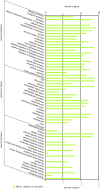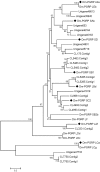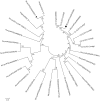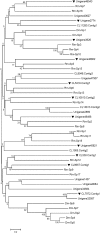Transcriptomic Analysis of Musca domestica to Reveal Key Genes of the Prophenoloxidase-Activating System
- PMID: 26156588
- PMCID: PMC4555219
- DOI: 10.1534/g3.115.016899
Transcriptomic Analysis of Musca domestica to Reveal Key Genes of the Prophenoloxidase-Activating System
Abstract
The proPO system regulates melanization in arthropods. However, the genes that are involved in the proPO system in housefly Musca domestica remain unclear. Thus, this study analyzed the combined transcriptome obtained from M. domestica larvae, pupae, and adults that were either normal or bacteria-challenged by an Escherichia coli and Staphylococcus aureus mixture. A total of 54,821,138 clean reads (4.93 Gb) were yielded by Illumina sequencing, which were de novo assembled into 89,842 unigenes. Of the 89,842 unigenes, based on a similarity search with known genes in other insects, 24 putative genes related to the proPO system were identified. Eight of the identified genes encoded for peptidoglycan recognition receptors, two encoded for prophenoloxidases, three encoded for prophenoloxidase-activating enzymes, and 11 encoded for serine proteinase inhibitors. The expression levels of these identified genes were investigated by qRT-PCR assay, which were consistent with expected activation process of the proPO system, and their activation functions were confirmed by the measurement of phenoloxidase activity in bacteria-infected larvae after proPO antibody blockage, suggesting these candidate genes might have potentially different roles in the activation of proPO system. Collectively, this study has provided the comprehensive transcriptomic data of an insect and some fundamental basis toward achieving understanding of the activation mechanisms and immune functions of the proPO system in M. domestica.
Keywords: Musca domestica; gene identification; genetics of immunity; prophenoloxidase-activating system; transcriptomic analysis.
Copyright © 2015 Li et al.
Figures











Similar articles
-
PAP1 activates the prophenoloxidase system against bacterial infection in Musca domestica.Dev Comp Immunol. 2021 Nov;124:104184. doi: 10.1016/j.dci.2021.104184. Epub 2021 Jun 23. Dev Comp Immunol. 2021. PMID: 34171367
-
Transcriptional response of Musca domestica larvae to bacterial infection.PLoS One. 2014 Aug 19;9(8):e104867. doi: 10.1371/journal.pone.0104867. eCollection 2014. PLoS One. 2014. PMID: 25137050 Free PMC article.
-
Negative regulation of prophenoloxidase (proPO) activation by a clip-domain serine proteinase homolog (SPH) from endoparasitoid venom.Insect Biochem Mol Biol. 2004 May;34(5):477-83. doi: 10.1016/j.ibmb.2004.02.009. Insect Biochem Mol Biol. 2004. PMID: 15110869
-
Prophenoloxidase system and its role in shrimp immune responses against major pathogens.Fish Shellfish Immunol. 2013 Apr;34(4):990-1001. doi: 10.1016/j.fsi.2012.08.019. Epub 2012 Aug 28. Fish Shellfish Immunol. 2013. PMID: 22960099 Review.
-
Genetic variability of a satellite sequence in the dipteran Musca domestica.EXS. 1991;58:106-12. doi: 10.1007/978-3-0348-7312-3_8. EXS. 1991. PMID: 1831154 Review.
Cited by
-
Anti-parasitic Peptides from Arthropods and their Application in Drug Therapy.Front Microbiol. 2016 Feb 5;7:91. doi: 10.3389/fmicb.2016.00091. eCollection 2016. Front Microbiol. 2016. PMID: 26903970 Free PMC article. Review.
-
De novo RNA-seq and functional annotation of Ornithonyssus bacoti.Exp Appl Acarol. 2018 Jun;75(2):191-208. doi: 10.1007/s10493-018-0264-9. Epub 2018 May 31. Exp Appl Acarol. 2018. PMID: 29855753
-
Comparative transcriptome and potential antiviral signaling pathways analysis of the gills in the red swamp crayfish, Procambarus clarkii infected with White Spot Syndrome Virus (WSSV).Genet Mol Biol. 2017 Jan-Mar;40(1):168-180. doi: 10.1590/1678-4685-GMB-2016-0133. Epub 2017 Feb 20. Genet Mol Biol. 2017. PMID: 28222204 Free PMC article.
-
Application of bacteria and bacteriophage cocktails for biological control of houseflies.Parasit Vectors. 2024 Jan 17;17(1):22. doi: 10.1186/s13071-023-06082-8. Parasit Vectors. 2024. PMID: 38233948 Free PMC article.
-
In-depth comparative transcriptome analysis of intestines of red swamp crayfish, Procambarus clarkii, infected with WSSV.Sci Rep. 2016 Jun 10;6:26780. doi: 10.1038/srep26780. Sci Rep. 2016. PMID: 27283359 Free PMC article.
References
Publication types
MeSH terms
Substances
LinkOut - more resources
Full Text Sources
Other Literature Sources
Molecular Biology Databases
